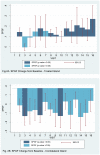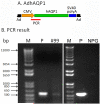Late responses to adenoviral-mediated transfer of the aquaporin-1 gene for radiation-induced salivary hypofunction
- PMID: 27996967
- PMCID: PMC5373995
- DOI: 10.1038/gt.2016.87
Late responses to adenoviral-mediated transfer of the aquaporin-1 gene for radiation-induced salivary hypofunction
Abstract
We evaluated late effects of AdhAQP1 administration in five subjects in a clinical trial for radiation-induced salivary hypofunction (http://www.clinicaltrials.gov/ct/show/NCT00372320?order=). All were identified as initially responding to human aquaporin-1 (hAQP1) gene transfer. They were followed for 3-4 years after AdhAQP1 delivery to one parotid gland. At intervals we examined salivary flow, xerostomic symptoms, saliva composition, vector presence and efficacy in the targeted gland, clinical laboratory data and adverse events. All displayed marked increases (71-500% above baseline) in parotid flow 3-4.7 years after treatment, with improved symptoms for ~2-3 years. There were some changes in [Na+] and [Cl-] consistent with elevated salivary flow, but no uniform changes in secretion of key parotid proteins. There were no clinically significant adverse events, nor consistent negative changes in laboratory parameters. One subject underwent a core needle biopsy of the targeted parotid gland 3.1 years post treatment and displayed evidence of hAQP1 protein in acinar, but not duct, cell membranes. All subjects responding to hAQP1 gene transfer initially had benefits for much longer times. First-generation adenoviral vectors typically yield transit effects, but these data show beneficial effects can continue years after parotid gland delivery.
Figures








References
-
- Jensen SB, Pedersen AM, Vissink A, Andersen E, Brown CG, Davies AN, et al. A systematic review of salivary gland hypofunction and xerostomia induced by cancer therapies: prevalence, severity and impact on quality of life. Support Care Cancer. 2010;18:1039–1060. - PubMed
-
- Vissink A, van Luijk P, Langendijk JA, Coppes RP. Current ideas to reduce or salvage radiation damage to salivary glands. Oral Dis. 2015;21:e1–e10. - PubMed
-
- Redman RS. Proliferative activity by cell type in the developing rat parotid gland. Anat Rec. 1995;241:529–540. - PubMed
MeSH terms
Substances
Associated data
Grants and funding
LinkOut - more resources
Full Text Sources
Other Literature Sources
Medical

